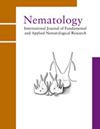Ditylenchus rafiqi n. sp. from pomegranate (Punica granatum L.) from India with a tabular key for the species known from India
IF 1.2
4区 生物学
Q2 ZOOLOGY
引用次数: 0
Abstract
Ditylenchus rafiqi n. sp. was recovered from the rhizosphere of pomegranate in New Delhi (India), and it is characterised by morphological, morphometrical and molecular methods. The new species is characterised by having a body length of 553-901 μm, delicate stylet (7-10 μm long), longer conus length (5.0-5.5 μm in females and 4.5-5.5 μm in males) with small round knobs sloping backward, seven lateral lines at the mid-body, median bulb well developed with thickening of lumen walls, a post-uterine sac well developed (27-47 μm), tail long, elongate conoid with an almost round terminus (45-74 μm) and male spicule of 15-17.5 μm, gubernaculum simple, leptoderan type of bursa enveloping the tail almost >50% of its tail length. A detailed study based on morphological and morphometrical methods clearly demarcates that D. rafiqi n. sp. differs from other known species of Ditylenchus. The molecular characterisation was done using D2-D3 of 28S rRNA and ITS rRNA markers. Molecular characterisation shows that the new species is closely related to D. acutus, D. gilanicus (D2-D3 marker), and D. medicaginis (ITS rRNA markers). Based on phylogenetic analyses using D2-D3 of LSU and ITS rRNA markers, D. rafiqi n. sp. forms an intermediate clade between the D. triformis and D. dipsaci groups.产自印度石榴(石榴属石榴)的一种属,印度已知种的表键
利用形态学、形态计量学和分子生物学等方法,从印度新德里石榴根际中分离得到拉菲奇双烯菌(Ditylenchus rafiqi n.sp.)。该新种的特征是体长553-901μm,细探针(7-10μm长),圆锥长度较长(雌性为5.0-5.5μm,雄性为4.5-5.5μ米),有向后倾斜的小圆形旋钮,身体中部有七条侧线,中间鳞茎发育良好,管腔壁增厚,子宫后囊发育良好(27-47μm),尾巴长,细长的圆锥形,末端几乎为圆形(45-74μm),雄性针状物15-17.5μm,单引带,钩端螺旋体型囊包住尾部,几乎超过其尾部长度的50%。一项基于形态学和形态计量学方法的详细研究清楚地表明,拉菲奇D.rafiqi n.sp.与其他已知的Ditylenchus物种不同。使用28S rRNA的D2-D3和ITS rRNA标记进行分子表征。分子鉴定表明,该新物种与尖齿D.acutus、尖齿D.gilanicus(D2-D3标记)和D.medaginis(ITS rRNA标记)关系密切。基于LSU的D2-D3和ITS rRNA标记的系统发育分析,D.rafiqi n.sp.在D.triformis和D.dipsaci类群之间形成了一个中间分支。
本文章由计算机程序翻译,如有差异,请以英文原文为准。
求助全文
约1分钟内获得全文
求助全文
来源期刊

Nematology
生物-动物学
CiteScore
2.60
自引率
33.30%
发文量
67
审稿时长
3 months
期刊介绍:
Nematology is an international journal for the publication of all aspects of nematological research (with the exception of vertebrate parasitology), from molecular biology to field studies. Papers on nematode parasites of arthropods, and on soil free-living nematodes, and on interactions of these and other organisms, are particularly welcome. Research on fresh water and marine nematodes is also considered when the observations are of more general interest.
Nematology publishes full research papers, short communications, Forum articles (which permit an author to express a view on current or fundamental subjects), perspectives on nematology, and reviews of books and other media.
 求助内容:
求助内容: 应助结果提醒方式:
应助结果提醒方式:


